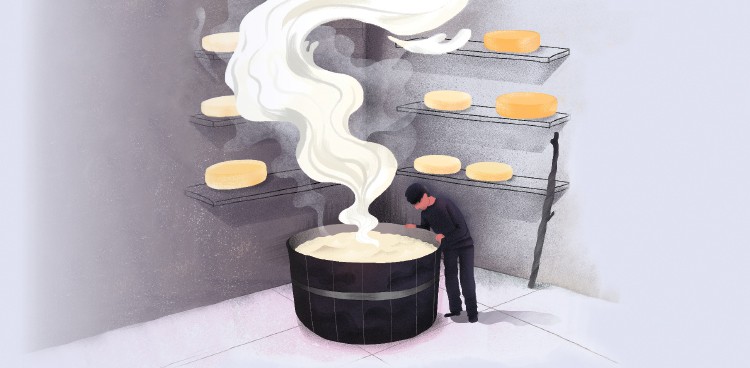
Shepherds watch over their herds as they move into greener pastures, up craggy rises, and along busy country roads to find the best browse. Where ruminants graze; where scorching summers threaten to curdle milk; where the ubiquitous sea spits salt—where preservation of dairy makes ultimate sense, Greek cheese is made.
I meet up with The Shepherd as the sun sneaks away. After enclosing his flock of some 50 lactating sheep (and a smattering of goats) in a cave near a river in the valley, we travel up into the Taygetos mountains to his home with the evening’s milk. He is a shadowy man with deep, cool eyes, and his voice grumbles so low it rivals a whale’s song. His two small, curiously blond boys play underfoot. His tough wife spends the evening cooking and passing down cheese implements through a trap door that leads to the cellar, where we spend the evening making sfela and myzithra.
Plumes of steam begin to rise slowly from the vat as he lightly heats the milk to make sfela. He makes it clear—with a bit of English, more Greek, and plenty of gestures—that he would ideally use the same copper vessel his great-grandfather heated over an open wood flame, but he has made the shift to a welded, water-jacketed, stainless steel vat of his own creation to control the milk’s temperature.
As we wait for flocculation, his wife hands down a bottle of wine and a knife. The wine is to drink, the knife to pry open a tin container packed with pure white cheese submerged in brine. One taste proves that this is indeed not feta but a cheese appropriately flavored to fit its local name of sfela: fire cheese. Lipase bites the tongue and floats up into the nostrils, like a member of the mustard family. The salt catches me off guard: One must be prepared for a mouthful of these mountain cheeses that traditionally sit in sea-salty brine to bypass the need for refrigeration.
I drool in utter cheesemaker fascination as he takes his cutting tool down from the rafters. It is crafted from a single branch of olive wood: a straight, perfect handle gives way to smaller spurs that have been worked to loop down and back to the shaft, creating a wooden tool like a balloon whisk and not unlike the Italian spino. He flips the tool over and indicates that the base of the handle is indeed flattened and whittled to a point. This is the edge he will use to make his first cut of the curd.
Though tonight we are making sfela, which The Shepherd sells in the small towns around Kalamata, but what is of true interest is the by-product of the market cheese: fresh myzithra. Greeks favor this whey cheese and will share their cultural understanding that it is considered to be all protein, no fat, and (when eaten fresh) very low in salt. It seems to be myzithra, this light whey cheese, that Greeks consume in such copious quantities as to classify them as the biggest cheeseeating nation worldwide.
After the cut, The Shepherd uses the entirety of his sinewy body to hand-stir the curd aggressively. He stops abruptly, knowing that this curd destined to become sfela is ready to be pulled from the whey and pressed.
The make leaves behind nutrient-rich whey. After an application of high heat, as curds precipitate out of the whey, he scoops them into a cheesecloth and expertly ties the bundle to hang and drain from the rafters of his home. Fresh myzithra is eaten quite wet—when it is still pillowy and bright and, in today’s case, hot—with a spoon.
Wine glass in hand, The Shepherd lowers his head into a nod and looks up with an eyebrow raised. We tap our wine glasses to the table and raise them with a resounding “γεια μας”: cheers to good cheesemakers!




